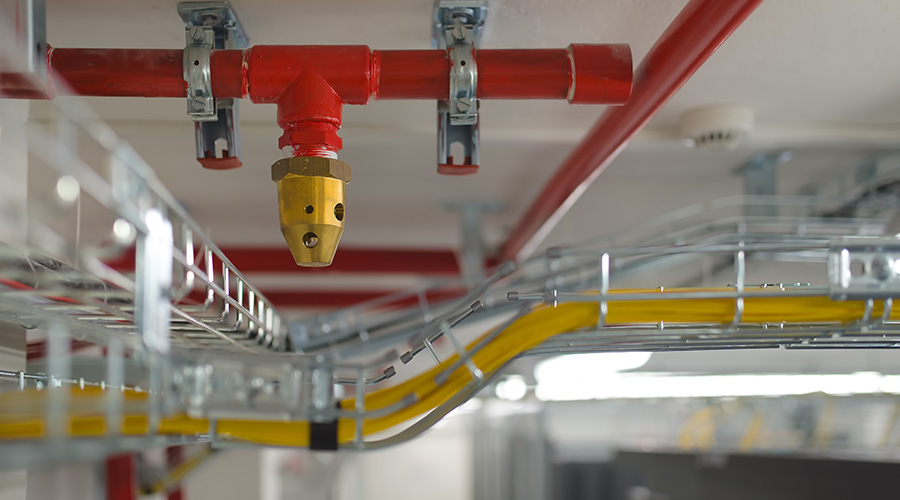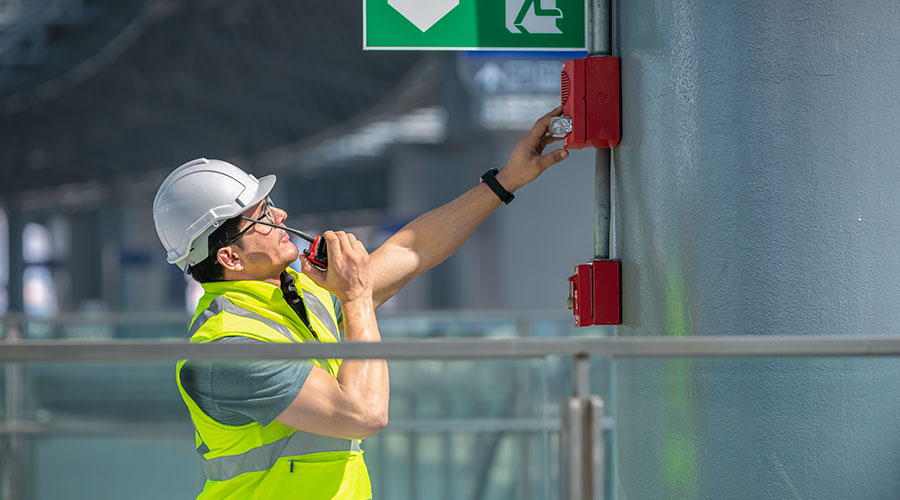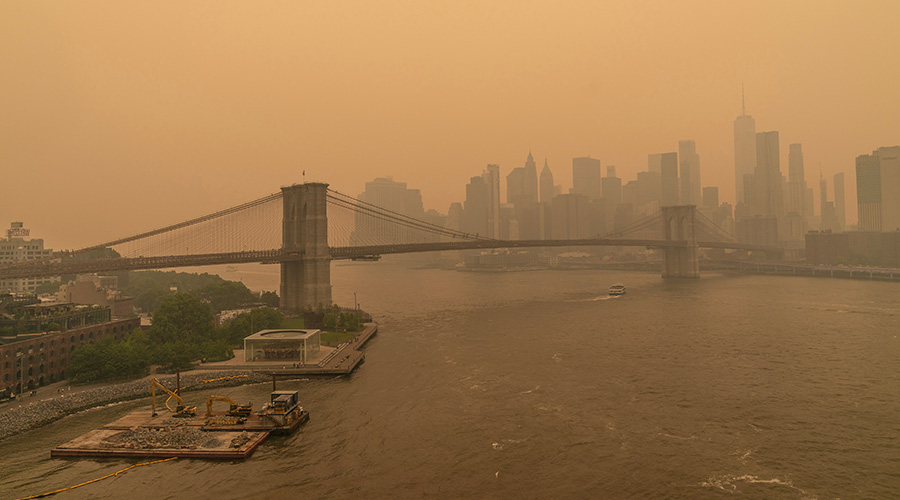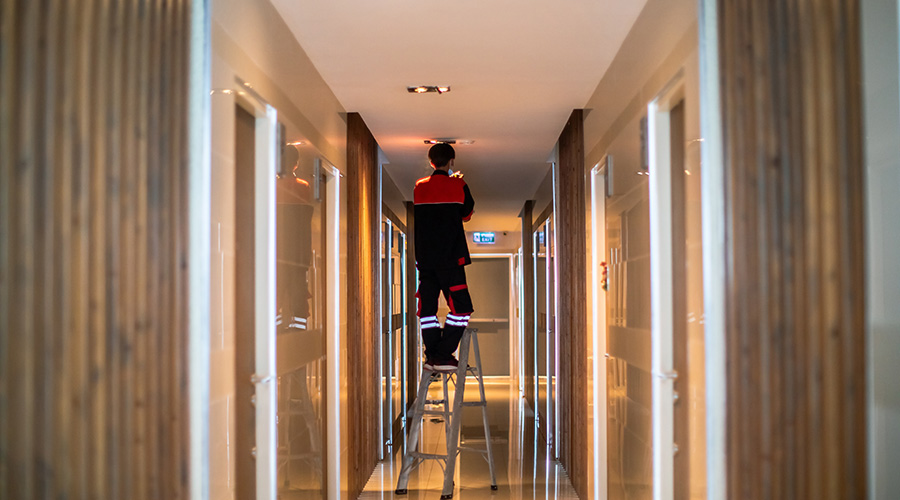Keeping Sprinklers Ready and Able
Following code-prescribed inspection, testing and maintenance schedules for sprinklers is essential if systems are to work when needed
Jet City Fix was performing an encore at the Fine Line Music Café in Minneapolis on Feb. 17, 2003, when a pyrotechnics display set the nightclub’s ceiling on fire. Some patrons reported thinking the fire was part of the act. The nightclub staff was under no such illusion. The band had never asked the club’s owner if it could use pyrotechnics.
Soon after the blaze started, staff members started ushering patrons out of the building while a sprinkler system in the 100-year-old building activated, helping firefighters douse the blaze within 15 minutes. About 120 people left the building without injury. The incident made the local newspaper, but didn’t receive much other coverage.
Three days later, similar circumstances led to a fire at The Station nightclub in Warwick, R.I. A band’s pyrotechnic display ignited a blaze on exposed foam and other flammable material near the stage. The fire spread quickly, killing 100 people and resulting in injuries to 160 others. The facility had no sprinkler system. The fire and resulting fatalities and injuries were national news for days afterward.
“That’s how successful the systems are,” says Cecil Bilbo, director of technical services for the National Fire Sprinkler Association. “Nobody hears about a fire when the sprinklers work.”
Building Owner Responsibility
Keeping fire sprinkler systems performing in top condition is a serious responsibility for building owners. National Fire Protection Association (NFPA) codes name owners as the party responsible for keeping sprinkler systems functioning and they are clearly the ones that face increased financial risk for allowing system maintenance to lapse. In addition, improper upkeep can cause owners to lose property insurance discounts that come with properly functioning systems and lead to serious legal trouble.
“The exposure to liability is huge if inspection, testing and maintenance is not done properly,” Bilbo says.
Although proper sprinkler system upkeep takes time and requires hiring a certified individual to perform certain inspections, tests and maintenance procedures, there is a well-prescribed list of what it takes to keep systems functioning properly.
Requirements Prescribed
The requirements of system upkeep are spelled out in NFPA 25, “The Inspection, Testing and Maintenance of Water-Based Fire Protection Systems.” Most states and local jurisdictions have adopted the association’s standard as part of building codes. Bilbo says building owners should think of upkeep requirements in the same way that NFPA named the standard: inspection, testing and maintenance.
Most inspection activities, particularly those required to be done every month, can be conducted by owners or a facility staff member. A majority of monthly inspection tasks entail reading and recording numbers of system pressure gauges and making sure control valves and alarm valves are accessible, undamaged and in the proper open or closed positions.
Quarterly, semi-annual, annual and less-frequent inspection, testing and maintenance activities are more involved and might require hiring qualified contractors. The frequency of certain tests varies with the complexity of the sprinkler system. For example, systems without a backflow preventer assembly are required to undergo what’s known as a main drain test every year; systems with such an assembly should have the test performed quarterly, Bilbo says.
A backflow test ensures that the amount of water expected to be used in a fire incident can flow through the system.
Some required inspection tasks are seemingly common sense, such as the annual requirements to make sure sprinkler heads appear free of physical damage and have not been painted. Other tasks, however, are less obvious and depend upon environmental factors and facility usage.
In systems fed with water containing a significant amount of minerals, for example, pipes and sprinklers might be more prone to corrosion and leaks than those fed with a purer water supply.
Moreover, changes in occupancy or layout of a facility should prompt owners to review whether sprinkler systems will perform properly. An NFPA report, “U.S. Experience with Sprinklers and Other Fire Extinguishing Equipment,” coauthored by Kimberly Rohr and John Hall Jr., offers a reminder that sprinkler systems need to be designed to fit the current needs of a property. The passage of time alone can dictate a system review, according to the NFPA report.
Frugality Pays
While many of the tasks that must be performed to maintain systems are not difficult, tracking required upkeep can be daunting. Sprinkler systems contain a variety of valves, gauges, pumps and other system components, each of which requires different tasks at different time intervals. Chapter 2 of NFPA 25 spells out the minimum requirements of routine inspection, testing and maintenance. Chapter 9 of the standard describes activities that should be undertaken to keep system valves in proper working order.
Keeping Track
The American Fire Sprinkler Association publishes charts titled “The Report of Inspection, Testing & Maintenance” that owners and facility staff members can use to keep tabs on required activities and the results of inspections and tests. Charts are available for both wet-pipe and dry-pipe sprinkler systems. A wet-pipe system is one in which water is constantly contained within the sprinkler system’s piping, from the main water supply to individual sprinkler heads. In the event of a fire, water is immediately released from sprinkler heads.
In a dry-pipe system, pressurized gasses, typically air or nitrogen, fill the system’s pipes between the main water feed and the sprinkler head. The pressurized gasses hold a valve closed between the main water supply and the system’s piping. In a fire, a sprinkler head opens and allows the gasses to escape, which releases pressure on the valve to the main water supply and allows water to enter the system. Dry-pipe systems are typically used in storage, warehouse and other unheated facilities where water in a wet-pipe system would freeze.
The performance record of sprinkler systems and their effectiveness in limiting property damage has drawn considerable attention from building code bodies, fire officials, the insurance industry and others.
NFPA, for example, has no record of a fire killing more than two people in a completely sprinklered public assembly, educational, institutional or residential building where the system was operating properly. What’s more, across all property types, sprinklers fail to operate in only 7 percent of fires considered large enough to activate the systems.
Sprinkler failure rates for specific property types are:
- Storage: 14 percent
- Public assembly: 10 percent
- Store or office: 9 percent
- Educational: 7 percent
- Manufacturing: 7 percent
- Health care or correctional: 5 percent
- Residential: 3 percent
The single-largest reason why sprinkler systems failed to operate when expected is because the systems had been shut off, according to NFPA data. Sixty-five percent of the cases in which sprinklers did not operate could be attributed to this reason.
Hall, the NFPA researcher who coauthored the report published in August 2005, says that figure has important ramifications for sprinkler maintenance. Although NFPA data does not indicate why sprinkler systems are shut off, one of the reasons that they could be turned off is to perform system maintenance. NFPA 25 prescribes a lockout/tagout program that can be used to avoid sprinkler systems being shut off and not turned on again.
Sixteen percent of cases in which sprinklers failed to operate are attributed to defeating the system manually, according to NFPA data. Hall says manual intervention is usually described as somebody shutting off the sprinkler system after it has been activated on the mistaken belief that a fire has been extinguished. Manual intervention also includes ventilation holes cut into walls and ceiling by firefighters in the attempt to fight a fire. Sometimes, those ventilation holes allow enough heat to escape from a facility that a sprinkler head is not activated.
“The system is being fooled into thinking there is no fire to fight,” Hall says.
Human Error
Failing to perform proper maintenance accounts for 11 percent of cases in which sprinklers did not operate as expected. Having an inappropriate sprinkler system design for the type of fire accounts for 5 percent of cases and damage to a sprinkler system component accounts for 3 percent of cases where sprinklers failed to operate.
Ninety-seven percent of cases in which sprinkler systems did not operate could have been prevented either through training or through the use of an appropriate lockout/tagout program, according to the NFPA report. Sprinkler systems could have reasonably been expected to operate in all instances except where the fire itself damaged system components.
“When sprinklers do not operate, it’s almost always because of human intervention,” says Bilbo.



Related Topics:














